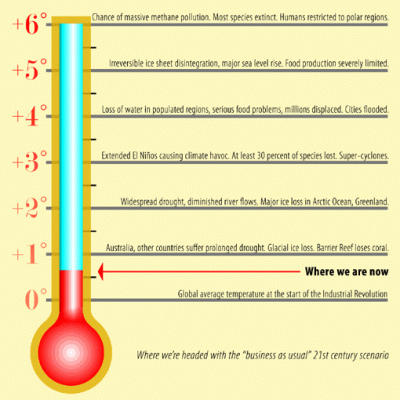Global warming caused by uncontrolled carbon emissions from human activities threatens life as we know it. [12 February 2008 | Peter Boyer]
Crisis: that’s the standard scientific terminology nowadays for the state of our planet’s climate. Chief NASA scientist James Hanson calls it a global emergency, and British physicist James Lovelock says we’d do well to prepare now for a very unpleasant future.
 Approaching our mellow Tasmanian autumn, we may find it hard to tune into such scenarios. We know a crisis as something that comes hard and fast, like a military attack, or a severe storm or bushfire, or unpayable interest-rate rises. What’s the big deal about a few degrees?
Approaching our mellow Tasmanian autumn, we may find it hard to tune into such scenarios. We know a crisis as something that comes hard and fast, like a military attack, or a severe storm or bushfire, or unpayable interest-rate rises. What’s the big deal about a few degrees?
The climate crisis has passed under many people’s radar – but as crises go you don’t get any bigger. It’s affecting some parts of the world ahead of our island, but eventually we’ll all feel the impact, and the longer we ignore the danger, the harder it will be when it comes.
Our planet has warmed 0.6 to 0.8 degrees in the past century, but the rate of rise is accelerating. The science shows that without serious cuts in greenhouse pollution the global average temperature will rise by between three and six degrees by 2100. What does all that mean?
To start, we need look no further than the present. In the 1970s scientists calculated that unabated fossil fuel use would start causing the world to get hotter around the turn of the century. Result: the past 11 years have seen the 10 hottest years on record.
Models also showed a likelihood of more prolonged droughts in parts of Africa, North America, southern Europe and southern Australia. Which is what happened – along with summer wildfires in Europe, of all places.
For the first time in recent history we’re seeing the limit of our food production, with world cereal reserves now down to less than two months’ supply. Ethanol production also uses food grains, which puts hungry people in direct competition with the world’s motorists.
We are seeing species becoming extinct at unprecedented levels, with one scientific study predicting that we will lose 50 percent of our species with less than three degrees of warming.
In Tasmania, despite last week’s rain we continue to suffer drought, with record low hydro storage levels limiting electricity generation. Drier, warmer, windier weather means wildfire threatens in places and seasons that would once have been considered safe.
Our oceans, forced to absorb more carbon dioxide, are getting more acidic while also warming up. Scientists are measuring a major oceanic “hot-spot” forming off Tasmania’s east coast – not a good omen for our cold-water fisheries.
Our current (accelerating) greenhouse pollution guarantees tougher times ahead whatever we do, but our future will turn into a nightmare with a business-as-usual scenario. For the full consequences of that, see the six degrees guide. This is not a nice story.
Six degrees: the future we don’t need
There is general agreement among scientists that we can’t avoid a rise in the average global temperature by at least a degree above pre-industrial levels. The probable effect of continuing emission trends of recent decades to the end of this century would be more than three degrees of increase, and possibly six degrees or more. Rises would be greater in polar regions.
One degree would increase the spread of desert in the United States, Africa and Australia, reducing land available for food production. Glacial ice would disappear from mountains in warmer places, and coral bleaching would be widespread on the Great Barrier Reef.
Two degrees would see Mediterranean Europe and China in the grip of drought, with river flow affected by diminishing glacier ice. Loss of Arctic sea ice and a diminishing Greenland ice sheet would have serious implications for species survival and sea level. Warmer, more acidic oceans would threaten many marine species.
Three degrees would extend El Niño events, causing climate chaos in many places including Australia. While some places would become wetter, desert will be extended on every continent – including the Amazon basin – reducing land for food. Around 30 percent of species would be extinguished. Super-cyclones would become frequent events.
Four degrees would see serious reductions in food yields in many parts of the world, including China and Pakistan, threatening millions of people. Rising seas, already inundating low-lying developing countries, would flood major western cities including London, New York and Melbourne. Desert would spread around temperate regions including Europe.
Five degrees would mean irreversible ice loss from the major ice sheets, with sea level rise measured in metres or tens of metres. Extreme storms, drought, flooding, wildfire would continue to play havoc on all continents. Wet places would become wetter, but desert would continue to expand everywhere, with calamitous loss of food production.
Six degrees or higher could trigger methane release from oceans, massively increasing greenhouse pollution. Most of today’s species would be extinct. Australia would have lost much of its capacity to produce food. Humans everywhere would be forced to migrate to cooler, wetter parts of the planet – and to compete with each other for diminishing resources.
